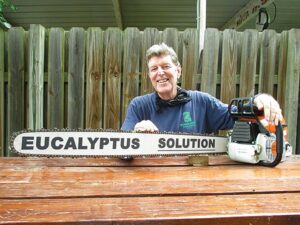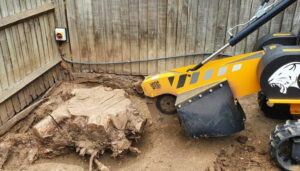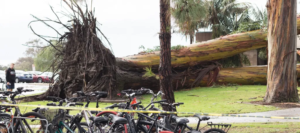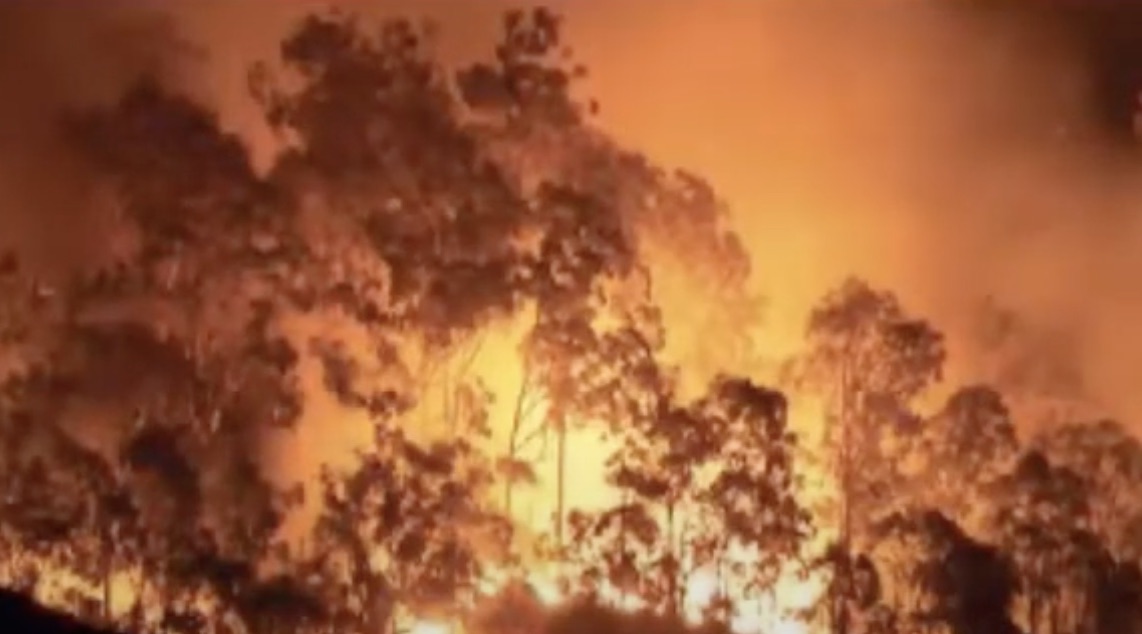|
Getting your Trinity Audio player ready...
|
OWN VOICE. ~ InPerspective by Gregg Dieguez —
It’s either them or us. It’s time to end the bureaucratic roadblocks to our homes, insurance, and evacuation safety. And it turns out, the County has had evidence since 2011 that this is also the correct ENVIRONMENTAL thing to do.
Images: most will enlarge for improved readability in a new window when you click on them.
We are not alone in our concerns about eucalyptus dangers, as it turns out. San Diego has undertaken a project for years to address the same risks we now face, and provides valuable Lessons Learned in this slide show. We have already documented in prior Buzz articles: the fire danger from eucalyptus “Hanging Fire: Eucalyptus Crown Fires and El Granada“, and techniques for removal “The Root of the Problem: Eucalyptus“.
But what of the environmental concerns about horned owls, butterflies, and so on? Turns out eucalyptus is doing environmental damage as we speak. In 2011, San Mateo County Resource Conservation District presented a study to the County which recommended removal of eucalyptus and identified the regulatory barriers which need to be removed to do so. Some cities have already removed barriers to eucalyptus removal, e.g. Pacifica and Half Moon Bay. So, 9 years later, what are we waiting for?
From that 2011 presentation: The Case Against Eucalyptus:
Eucalyptus was introduced to California by Australians in the 1850’s during the California Gold Rush. Learning that the huge trees grew easily in temperate climates with little regard to soil or water, they seemed the perfect crop to provide a renewable source of timber for construction, furniture making, railroad ties, and fuel in the rapidly growing state. Blue gum (Eucalyptus globulus), which is native to the east coast of Tasmania, proved valuable as windbreaks for highways and farms and has become the most common large eucalyptus in California. By the early 1900s, thousands of acres of eucalyptus were planted, replacing oak woodlands and other native habitat.
The resulting non‐native monoculture has raised concerns about loss of biological diversity. Eucalyptus replaces a diversity of native plant species, including forage for wildlife, is purported to cause mortality in native bird species, and may disrupt native bird migratory patterns (CAL EPPC, 2004). Eucalyptus trees shade out native understory and deposit allelopathic leaf litter that inhibits the germination of native seeds (Bossard, et al., 2000, Doerr et al., 2005). Loss of food, shelter, and nesting sites for birds, small mammals, and bee colonies has been documented (WESCO, 1993). In addition, eucalyptus forests promote fire with their prolific combustible oil, copious litter, and long shreds of hanging bark that carry flames to the crowns (Esser, et al., 1993). Stands of mature eucalyptus have also been associated with altering local hydrology. The hydrophic nature of the leaf litter has been shown to increase soil water repellency (Thompson, et al., Ferreira et al., 2000). The result is an increase in surface water runoff, higher rates of erosion and sedimentation, and a decrease in groundwater recharge. Eucalyptus trees show high rates of evapotranspiration, extracting water at great depths and under dry conditions (Bell and Williams, 1997, Pryor, 1976). Removal of eucalyptus from a riparian corridor has been shown to increase creek flows and/or maintain flows later into the summer (Thompson, 2008).
While eucalyptus appear to provide ecological niches for butterflies and raptors formerly filled by natives plant species, the loss of native plant forage for wildlife, as well as migratory disruptions may have a greater long term impact on a wider diversity of species, including invertebrates and microorganisms in soil (CALEPPC, 2004). Except for providing occasional nest sites for Great Horned Owls and Red‐shouldered Hawks, non‐blooming “eucs” do not provide much food or shelter for native birds or other animals and cause areas of ecological emptiness that could otherwise by viable habitat if planted with native trees (Stallcup, 1997). Blooming “eucs” can actually harm native birds. As their physiology is not adapted to seek insects or nectar within eucalyptus blossoms, they must insert much of their heads, thus glopping up their faces and resulting in suffocation (Stallcup, 1997). During winter (October to March), many “eucs” produce abundant flowers, which in turn attract insects and inviting bird species. Without the presence of the “eucs”, many of these birds would migrate, as they should, into the American tropics (Stallcup, 1997). [As has been pointed out elsewhere, the butterfly used eucs as ‘homes of opportunity’ and are NOT their native nesting habitat.]

Full details can be read in this report, from which the above paragraphs were excerpted.
CalFire officials have admitted, off the record, that there will be no way to protect homes from the next lightening-caused crown fire. They may get the people out, but entire towns could be wiped out.
The biggest issues with removal will be:
A) the cost. Property owners should consider that the money for fire insurance they would pay for, but can’t get, should be redirected as ‘seed funds’ into grants from government agencies in order to attract ‘matching funds’. As we’ve seen with the HMB library, “matching funds” can be 75% or more of the total. Kellyx Nelson of RCD pointed out to me something that I long knew from my business career: “Money Attracts Money.” If people are willing to put up money with their mouths, things will get done faster.

B) the “aesthetic shock” of a change in landscape to residents and visitors. And there very well could be complaints. That will take communication and outreach to resolve by displaying the Restoration Habitat. But I submit that a greater shock will be loss of life and homes (especially UNINSURED homes, because policies are being cancelled and not issues). Having a eucalyptus on your property, for privacy or whatever reason, is like not wearing a mask in a public place. You’re putting everyone else, as well as yourself, at risk (of COVID-19, nowadays).
__________________________________________
Extra Credit: For a brief History of Eucalyptus in California, click here.
More From Gregg Dieguez ~ InPerspective
Mr. Dieguez is a native San Franciscan, longtime San Mateo County resident, and semi-retired entrepreneur who causes occasional controversy on the Coastside. He is now a candidate for the MCC. In 2003 he co-founded MIT’s Clean Tech Program here in NorCal, which became MIT’s largest alumni speaker program. He lives in Montara. He loves a productive dialog in search of shared understanding.







Replace with what? What species of tree doesn’t burn?!
Redwood, but stay tuned as this needs to be studied. IIRC Oak also is more resistent. At any rate, Eucalyptus is one of the most flammable, and with a shallow root system much more likely to topple over a road and trap evacuation. The final answer needs to come from the experts, whether at RCD or elsewhere.